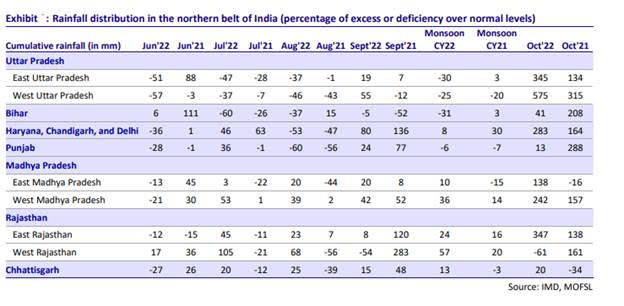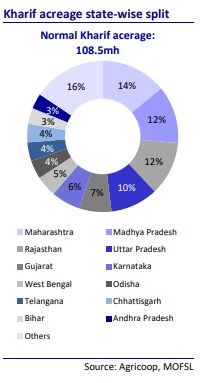Basis the interaction with various farmer producer organisations (FPOs) and farmers across India to gauge the on-ground situation regarding crop conditions, the quantum of rainfall, cost of cultivation, and farm profitability during the Kharif season in CY22, Motilal Oswal Financial Services (MOFSL) in a study noted that any fall in prices on the arrival of the new produce will lead to lesser realisations for farmers. Considering the fall in crop prices and the higher cultivation cost, farm profitability for key Kharif crops will be muted. The company further said that the overall farm profitability is expected to be lower in the entire northern region of India, except Chhattisgarh, and in Maharashtra, while the entire southern belt and West Bengal are expected to report higher farm profitability.
Muted Kharif production given the uneven rainfall
According to the first advance estimate of crop production released by the Ministry of Agriculture & Farmers’ Welfare, production of Kharif foodgrains and oilseeds is expected to decline by 4 per cent and 1 per cent respectively YoY to 150 and 23.6 MMT, while sugarcane output is expected to rise by 8 per cent to 465 MMT in FY23. Cotton output is expected to rise by 10 per cent YoY to 34.2m bales, while that of jute is expected to fall by 2 per cent to 10.1m bales. The expected decline in foodgrain production was majorly led by the 5 per cent and 4 per cent YoY fall in the area under rice and pulses sowing.
You may also like to read: ICRISAT-ADB high-resolution spatial maps to enable cropland mapping for insurance claims
As per the India Meteorological Department (IMD), rainfall during the CY22 monsoon season (from 1st Jun’22 to 30th Sep’22) stood at 925mm, 6 per cent above normal rainfall levels of 869mm. At the sub-divisional level, 18 sub-divisions (covering 43 per cent of the total area of India) received normal rainfall during the CY22 monsoon season, while 12/six sub-divisions (covering 40 per cent/17 per cent of the total area of India) received excess/deficient rainfall. However, rainfall was very heavy in the first 18 days of Oct’22 (79 per cent above normal levels in India; 3.5x of the normal levels in northwest India). These untimely heavy rains during the harvest season led to significant crop losses in various parts of India.
 High cost of cultivation to impede farm profitability
High cost of cultivation to impede farm profitability
 According to the MOFSL study, “human labour accounts for 51 per cent of the total cost of cultivation (on an average for key Kharif season crops). The same marginally fell 1 per cent YoY in the CY22 Kharif season. However, all other costs saw a major rise, with machine labour (17 per cent of the cost of cultivation) clocking the highest rise (at 70 per cent YoY). Fertiliser and agrochemical prices (10 per cent and 4 per cent respectively of the cost of cultivation) grew 13 per cent and 12 per cent respectively YoY. Any fall in prices on the arrival of the new produce will lead to lesser realisations for farmers. Considering the fall in crop prices and the higher cultivation cost, farm profitability for key Kharif crops will be muted. Overall input cost is estimated to have risen by 14 per cent YoY in the CY22 Kharif season (Jun-Sep’22) due to the higher inflation in major inputs.”
According to the MOFSL study, “human labour accounts for 51 per cent of the total cost of cultivation (on an average for key Kharif season crops). The same marginally fell 1 per cent YoY in the CY22 Kharif season. However, all other costs saw a major rise, with machine labour (17 per cent of the cost of cultivation) clocking the highest rise (at 70 per cent YoY). Fertiliser and agrochemical prices (10 per cent and 4 per cent respectively of the cost of cultivation) grew 13 per cent and 12 per cent respectively YoY. Any fall in prices on the arrival of the new produce will lead to lesser realisations for farmers. Considering the fall in crop prices and the higher cultivation cost, farm profitability for key Kharif crops will be muted. Overall input cost is estimated to have risen by 14 per cent YoY in the CY22 Kharif season (Jun-Sep’22) due to the higher inflation in major inputs.”
The southern belt of India witnessed a better Kharif season on the back of a good monsoon and lower crop losses YoY. Farm profitability was hampered YoY in the northern belt of India (Bihar, Chhattisgarh, Punjab, Madhya Pradesh, Uttar Pradesh, Haryana, and Rajasthan). States like Uttar Pradesh/Bihar were the worst affected due to the delayed arrival of the monsoon (37-47 per cent/60 per cent lower than normal levels in Jul’22) and extremely heavy rainfall in the first 18 days of Oct’22 (i.e. during the harvest season; above 5x/7.5x/61 per cent of normal levels for eastern UP/western UP/Bihar), the study says.
You may also like to read: Enabling climate-resilient agriculture with agritech
The same in the western and eastern regions of India was a mixed bag, with Gujarat and West Bengal witnessing a decent Kharif season (rainfall was 19-39 per cent higher than normal levels in Gujarat). However, farm profitability in Maharashtra was the worst affected due to heavy rainfall (9-31 per cent higher than normal levels; rose to 70-106 per cent in Jul’22). The situation in the state was further aggravated by pink bollworm and snail infestation, which affected the cotton and soybean crops, respectively, the MOFSL further says.
 According to the study, the states with a higher sowing area under crops like maize, bajra, and groundnut will witness better profitability on the back of higher crop prices. Rajasthan has the highest contribution of these crops (accounting for 49 per cent of the total state’s sowing area), followed by Gujarat (30 per cent), Karnataka (25 per cent), Tamil Nadu (25 per cent), and Andhra Pradesh (22 per cent). However, profitability in Rajasthan was hampered by heavy crop losses due to the untimely heavy rains in the eastern part of the state (4.5x of normal levels) in Oct’22 (harvest season).
According to the study, the states with a higher sowing area under crops like maize, bajra, and groundnut will witness better profitability on the back of higher crop prices. Rajasthan has the highest contribution of these crops (accounting for 49 per cent of the total state’s sowing area), followed by Gujarat (30 per cent), Karnataka (25 per cent), Tamil Nadu (25 per cent), and Andhra Pradesh (22 per cent). However, profitability in Rajasthan was hampered by heavy crop losses due to the untimely heavy rains in the eastern part of the state (4.5x of normal levels) in Oct’22 (harvest season).
“The states such as Gujarat, Karnataka, Tamil Nadu, and Andhra Pradesh (with higher acreage under maize, bajra, and groundnut and lower crop damage) are likely to witness better farm profitability. In the fertiliser space, we have a Buy rating on CRIN. In the agrochemicals space, we have a Buy rating on PI and GOAGRO and a Neutral rating on UPLL. The outlook for the upcoming Rabi season remains encouraging as rainfall at the pan-India level was over 6 per cent of normal levels in the CY22 monsoon season (v/s sub-1 per cent in CY21), leading to higher reservoir levels (up 8 per cent YoY) at the end of Oct’22,” MOFSL said.





The study predicts lower farm profitability in most of northern India and Maharashtra, while the southern belt and West Bengal are expected to see higher profitability, and the Ministry’s estimates indicate a decline in Kharif foodgrains and oilseeds production but an increase in sugarcane and cotton output.